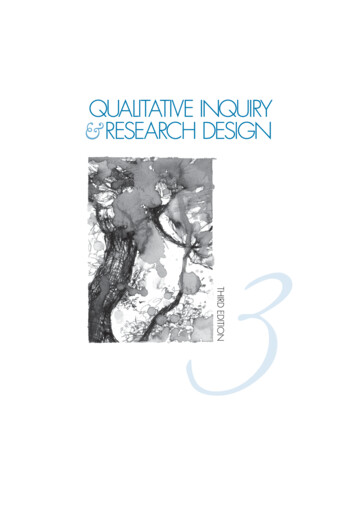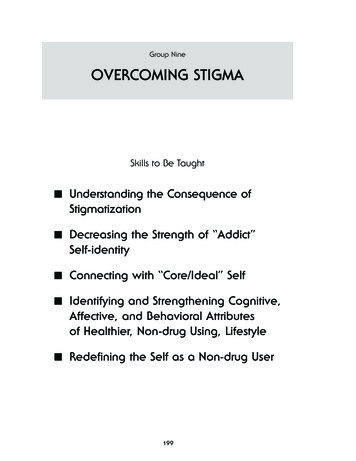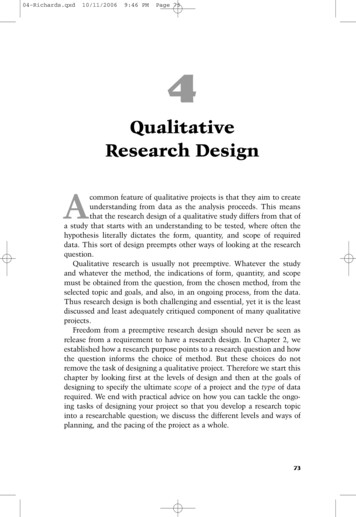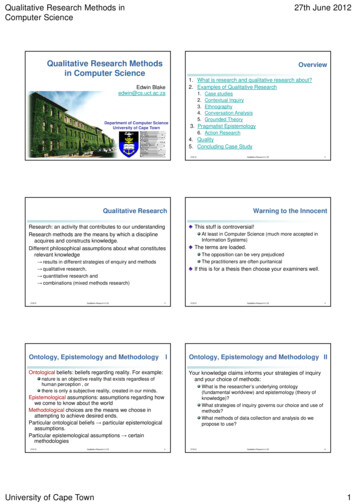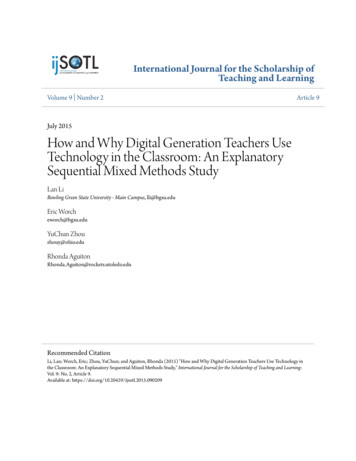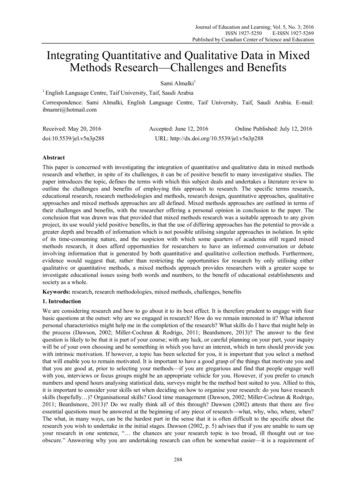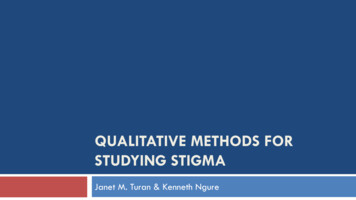
Transcription
QUALITATIVE METHODS FORSTUDYING STIGMAJanet M. Turan & Kenneth Ngure
Rationale for using qualitative methods Stigma is something not easy to define and yet experienced veryintensely by individuals and groupsQuantitative measures may simplify and not be able to really get atthe experience(s) of stigmaQualitative methods allow us to dig deeper, explore nuances, anddelve into seeming contradictionsQualitative methods help us to understand why and how stigmaoperates
Qualitative Approach and Methodological options Qualitative approaches /traditions: Groundedtheory Phenomenology Narratives Case Studies Ethnography Etc. Classic qualitative datacollection methods: In-depthinterviews Cognitive interviews Focus groups Observation (part or non-part) Content analysis of documents,websites, video, art, etc. Etc.
Less-Used, Innovative Methods Photo-VoiceMystery Shopper approachesLongitudinal (repeated) qualitative interviewsDyadic qualitative studiesAnalyses of social media postsVirtual focus group methods e.g.,asynchronous online focus groups with female-to-male trans masculine(TM) transgender individuals (Reisner et al., 2018)
Challenges Can be a sensitive and emotional topic for people to talk about (but that’sone reason why qualitative methods are good!)Interviewers may initially be uncomfortable asking people about stigmaSometimes people have a hard time articulating how stigma affects themAcademic language regarding stigma is rarely the same as the way peopletalk about itIt can be difficult for people to disentangle different types and dimensionsof stigma that they experience (intersectionality)Sometime people say they experience NO STIGMA, but often it is becausethey hide their stigmatized identity
General Tips Stigma is a sensitive topic, but if it is handled sensitively byinterviewers, people usually appreciate the chance to talk about itEliciting personal stories and/or getting people to react to vingnettescan be useful toolsActive listening and probing are particularly important to discoverexperiences of anticipated and internalized stigma.People who may be perpetuating stigma (e.g., healthcare workers)may be reluctant to recognize or admit that they are doing somethingthat might stigmatize others; can ask them to talk about what theyhave seen others do
Sampling Use purposive/theoretical sampling to make sure you are includingappropriate variation in your study populationMake sure you are including important minority groups and voicesMake sure you include sufficient numbers according to variables thatare theoretically important in stigma research Age,sex Time since diagnosis Other stigmatized identities You may want to sample according to levels of stigma in a surveyand/or achievement / non-achievement of a health outcome (e.g.,viral suppression) in the context of a mixed methods design
Example sampling plan for stigma focus groupsMSM living with HIVVirally suppressed3 groupsTransgender womenliving with HIV3 groupsNot virally suppressed3 groups3 groupsA total of 12 focus groups (N 72-96 participants)
The Interview / Focus Group Guides Come up with good non-judgmental open-ended questions that elicitstories of how people have experienced (or avoided) stigma anddiscriminationThose stories will allow researchers to get an insider’s view of howpeople experience and react to stigmaStart out with less sensitive topics to break the ice, placing the criticalquestions around stigma in the middle of the interview guide, andwinding down at the end with less emotional topics for good closure
Coding and Analysis Pay attention to:Types of stigma (e.g., HIV, TB, poverty, cancer, sex work, etc ) Sources of stigma (family, community, health workers, intimate partner, etc ) Dimensions of stigma (anticipated, internalized, perceived community, enacted,etc.) Multiple levels of stigma (individual, interpersonal, community, structural) Mechanisms for the effects of stigma (mental health, stress, etc ) Resiliencies that may counteract stigma (social support, coping, empowerment, etc.) Rapid analysis techniques can be useful to get quick data for stigmareduction intervention development / adaption
Pros and cons of remote qualitative data collection? Pros:May be easier for people to participate from various locations around thecountry/world Can be perceived as more confidential (video off) Protects from exposure to COVID-19 Cons:Not as easy to detect body language and other non-verbal clues Some people not able to access or are not comfortable with the technology May make it more difficult for interviewers/moderators to really connect withparticipants See Reisner et al., Qual Health Research, 2018
Example Study: Women’s Adherence and VisitEngagement Study (WAVE)(R01MH104114, 2015-2019)Lead Investigators: J. Turan, B. Turan, S. Weiser, M. Johnson, and T.NeilandsStudying Mechanisms and LongitudinalEffects of Stigma on Women's Adherenceand Outcomes in the national Women’sInteragency HIV Study (WIHS)Funded by the U.S. National Institute of Mental Health (NIMH)
The Women’s Interagency HIV Study(1994-present)
Aim 3To examine the link between intersectional stigma—including stigma related to HIV, race/ethnicity, poverty,and gender—and adherence to HIV treatmentrecommendations using mixed methods research. Qualitative in-depth interviews with women living with HIV Questionnaires including validated measures of:––––HIV-related stigmaRacismSexismPoverty stigma
WAVE Study Qualitative Research onIntersectional Stigma**Rice WS et al., Perceptions of intersectional stigma among diverse women living with HIV inthe United States, Social Science & Medicine, 2018
Characteristics of Qualitative InterviewParticipants (N 76) WIHS Site:13 in Birmingham AL 13 in Jackson MS 25 in San Francisco CA 25 in Atlanta GA Race: 46 African American, 20 Caucasian, 6 multiracial, 1 Native American, 3 Not reportedEthnicity: 5 Hispanic or LatinaIncome: 63 low income; 13 mid-upper incomeSexuality: 6 bisexual, 5 lesbianAge: 34 aged 50 years or older
The Interview Guide: The beginningAIM 3 QUALITATIVE INTERVIEW GUIDE RELATED TO INTERSECTIONAL STIGMAThemeIce-breaker/introINTERVIEW QUESTIONS Can you tell me a little about the neighborhood/area where you live? What doyou like about it? What do you not like about it? What comes to mind when I ask you about “your community”? Do you think aboutthe place where you live? Another place or group of people? Who do youconsider a part of your community?TransitionThanks so much for sharing that. Now that we have gotten to know each other a littlebetter, I’d like to move into some of the main topics that we want to cover in thisinterview.
The interview guide: Eliciting barriers andfacilitators to adherence to HIV treatment First, can you share with me the story of how you were first diagnosed with HIV? Can you tell me about howand when you first got into HIV care after being diagnosed? Can you tell me about your visits to a doctor for regular HIV care? (By regular HIV care, I mean a visit to aclinic or doctor's office to have a check-up on how you're doing with your HIV. This does not include sickvisits, emergency services, or hospital admissions for HIV; it does not include visits that are only for lab orblood work or X-rays, and it does not include your WIHS study or other research visits.) Have you been going for regular HIV care visits, and if so, how is that going for you?
The interview guide: stigma questionsTransitionSome of the barriers you have already mentioned (or that many people talk about) are stigma (thenegative ways that that people are viewed or feel because of their differences) and discrimination(being treated badly by others because of these differences). I would like to talk more about thesetopics now. I understand that these are sensitive topics, and some of these questions may bring tomind painful experiences. You are welcome to share only what you feel comfortable with, and canstop or take breaks at any time.Types of stigmaandWhat kinds of opinions or attitudes do you think people have about women living with HIV? Whatstereotypes do you hear about women living with HIV? (Or what assumptions do people make aboutwomen living with HIV?)Probes: What do people say about them as women?discrimination What do people say about them as mothers? What about their lifestyle? (substance use, sex life, etc.) In your opinion, what is going through the minds of people who discriminate against women living withHIV?Can you describe a time when you felt stigmatized or discriminated against?
Coding and Analytic Process Transcripts were coded and analyzed according to Braun & Clarke’s steps ofqualitative thematic analysis.A team of researchers developed an initial list of codes after data collection began.A priori codes were informed by intersectionality theory, literature review, theinterview guide, and an initial review of the data.Four researchers coded all transcripts using DedooseTwelve transcripts were double-coded in order to establish agreement on codingdefinitions and procedure.After coding, we ran queries to enable thematic comparisons between data taggedwith different codes, or combinations of codes.Documents summarizing emerging ideas and concepts and patterns across transcriptswere shared among the research team and discussed in group meetings.
Findings: Intersecting stigmas experienced by diversewomen living with HIV in the US Most commonly: GenderRacePovertyBut also: IncarcerationAgeWeight“All my life I've always wonderedwhat people discriminated againstme for. Is it because I was Black? Isit because I was biracial? I neverknew if people were discriminatingagainst me because I was HIVpositive, because I was a woman.Honestly, I don't know what. I can'tlike really pinpoint. I just know thatsomething. I guess it is like a gutfeeling. Something just didn't feelright. Like somebody insulted meand like later I'm like what was thatfor?”
Sexism, Sex Work Stigma, and HIV“The men can do what they do and the women shuttheir mouths and take it. Women can’t do anythingabout it. That’s the whole culture They downgradea lot of us women who are prostitutes. ‘They arestreet girls, so HIV is what they get.’”
Racism, Sexism, and HIV“Yes, stigma affects me personally Because, I’m awoman that’s living with HIV and I’m a black woman,too. So, I’m just kind of, I’m calling out these things awoman, and then a black woman, because these arethings that’s been stigmatized the worst.”
Poverty Stigma and HIV“ people just talk down on the poor women, and tothe rich ones, people are just sorry that it happened,and then people are off to another subject. The poorones, people are just constantly beating them up.Poor women already feel bad about their HIV status,but they constantly just are being reminded of it Itis a battle.”
Conclusions Intersectional approaches have the potential to uncover the complexity ofsocial processes of marginalization, barriers to accessing health and socialservices, and strategies employed to navigate stigma.HIV serostatus, race, gender, economic status, and sexuality areinterdependent and profoundly shape life experiences, opportunities, andhealthcare access and uptake.The rich complexity of women's lives in this study highlight the need forpublic health strategies to consider community, interpersonal and structuraldimensions across intersecting, interdependent identities to promote thewellbeing, and reduce social and health disparities among women livingwith HIV.
WAVE Acknowledgements WIHS participants!UAB/MS Janet Turan Bulent Turan Mirjam-Colette Kempf Deborah Konkle-Parker Zenoria Causey Samantha Whitfield Whitney Smith Rice Celine Atkins Venetra McKinney Ilene BrillEmory WIHS Gina Wingood Igho Ofotokun Nikia Braxton Sara Sanford Kayla SmithUniversity of Colorado, Denver Mark Laudenslager UCSF WIHS Sheri Weiser Mallory Johnson Torsten Neilands Jennifer Cohen Karen Kavanagh Tessa Napoles Abigail Batchelder Abigail HatcherCollaborators Carmen Logie Tracey Wilson Melonie Walcott Andrea Norcini PalaFunders– NIMH #R01MH104114– NIMH #R01MH095683– NIAID WIHS Unobligated Funds
MANIFESTATIONS OF STIGMA IN THE CONTEXTOF A NATIONAL ORAL PRE-EXPOSUREPROPHYLAXIS SCALE-UP PROGRAM IN KENYAInvestigators1DanielWere, 3Kaitlyn Atkins, 1Abednego Musau, 2MaryaPlotkin, 2Kelly Curran, 2Jason Reed1 Jhpiego,Kenya2 Jhpiego,USA,3 JohnHopkins Bloomberg School of Public Health
Introduction Kenya included PrEP in national guidelines in July 2016 In May 2017, Kenya launched a national PrEP scale up program Uptake has been progressive, but slow among some sub populations, andoverall continuation rates consistently low Stigma was documented as a substantial barrier during PrEPand demonstration projects29clinical trials
The Jilinde Project Four year project that seeks to demonstrate effectivePrEP integration and delivery at scale, in low resourcesettings Implemented in 10 out of 47 counties in Kenya PrEP provided through 93 sites to:Men whohave sexwith (SDC)Generalpopulation(GP)Adolescentgirls &youngwomen(AGYW)30
Methods A qualitative study associated with Jilinde programmatic scale-up was conductedbetween October 2017 - November 2018 22 focus group discussions (FGD) and 30 in-depth interviews (IDIs)Aim: to understand how stigma towards PrEP use is experienced in routine servicedelivery, in order to improve PrEP outcomesEthical approvals were obtained from Kenya Medical Research Institute (KEMRI)and Johns Hopkins Bloomberg School of Public Health (JHSPH), and eachparticipant provided informed written consentPurposively sampled former, current and potential PrEP users (FSW, MSM, AGYW),parents and sexual partners of AGYW, peer educators, and PrEP health careprovidersConducted thematic data analysis31
Socio-demographic CharacteristicsPopulation TypeParticipants (n 227)Mean age(Years)SexMSM36 (16%)26All maleFSW28 (12%)31All femaleAGYW86 (38%)21All femaleParents of AGYW12 (5%)4450% were maleMale partners of AGYW10 (4%)22All maleHealth care providers29 (13%)3240% were malePeer educators (FSW & AGYW)26 (12%)27All female32
Summary of KeyFindingsClient outcomes of stigmaS T I G M ATypesSources ProductBehaviorExpressionsCommunity Labelling Sexual partners Stereotypes Health careproviders Prejudice Shame Loss of'business' Fear of rejection Reputational damage Intimate partner violence Discrimination by providersAGYW PeersIdentity Family DiscriminationMSMFSWProgrammatic Impact Low PrEP uptakeand continuation
Types ofStigma1Product stigma“I have kept it a secret because thebottle is similar to that of ARVs.Someone who doesn’t know about PrEPcould think you have HIV ”(20 year old, AGYW PrEP user)34
Types of Stigma2“MSM is seen assomething bad, theytake it as a curse. Sowhen you are nearthem they reject you.They will be likeeeeh you are a maleprostitute ”Identity stigma“For male sex workers andMSM, you feel you areserving people youdespise. Whowantsto deal with thesepeople?”(20 year old, MSM PrEPuser)(33 year old, female clinician)35
Types of Stigma3Behavior Stigma“My mother told me I have takenthose drugs because I want to be aprostitute, so that even if I sleepwith men, I don’t get the disease ”(22 year old, AGYW PrEP user)36
Sources of Stigma
Expressions ofStigma12Discrimination“If you go for a refill, you willwait for so long because someof the clinicians don’t want tosee PrEP clients. When theyhear that this is a PrEP client,they say, ‘Tell them to waitfirst’ ”Prejudice“The reality is when thefemale sex workers come, ifshe is coming with an STI, youtreat but with this attitude of,okay, it serves you right ”(24 year old, AGYW Peer Educator)(41 year old, male clinician)38
Expressions ofStigma3Stereotypes“I’m really worried of thisdrug, PrEP, the children willbecome promiscuous. She willjust be having sex withdifferent men to get money.”4Labelling“When you go to the hospitalto collect the drug and youmeet someone you know, theysay “So you take the HIVdrugs, so you have AIDS.”(58 year old, parent of AGYW)(22 year old, AGYW, discontinuedPrEP)39
ClientOutcomes ofStigma1Intimate partner violence2Fear of rejection3Provider discrimination4Loss of business5Shame & reputational damage“I feared how I would tellthe old man I was usingPrEP because he wouldbeat me.”(23 yr old, AGYW40PrEPuser)
ProgrammaticImpact of Stigma1“I stopped when wequarreled with myboyfriend. I had to stop inorder to be at peace withhim ”(22 year old, AGYW,discontinued PrEP)Low PrEP uptake &continuation“What made me to stoptaking PrEP was my twofriends who said that I wasHIV positive ”(22 year old, FSW,discontinued PrEP)41
Conclusions Stigma was a major contributor to peoples’choices around initiation and continuation of PrEP; Stigma around the product,Stigma around clients’ behavior and identityWhile stigma was manifested differently for diversepopulations, it was described as a major barrier to bothuptake and continuationPrEP delivery programs should: Prioritize interventions to address HIV related stigma at all levels, includingsensitivity training for providersIntensify awareness creation efforts to norm PrEP42
Acknowledgements Bill & Melinda Gates FoundationJilinde Partners (Jhpiego, NASCOP, Avenir Health, PSK, ICRH-K)National PrEP and Key Populations Technical Working GroupsGilead Health SciencesUS President’s Emergency Plan for AIDS Relief (PEPFAR)LINKAGES, GEMS and OPTIONS projectsPrevention Market Manager (AVAC & CHAI)Partners Scale Up ProjectMinistry of Health and County governments in KenyaLocal Implementing Civil Society Organizations43
Questions?
Less-Used, Innovative Methods Photo-Voice Mystery Shopper approaches Longitudinal (repeated) qualitative interviews Dyadic qualitative studies Analyses of social media posts Virtual focus group methods e.g., asynchronous online focus groups with female-to-male trans masc
